The modern history of Cyprus begins in 1878 when the United Kingdom took over the island, formerly ruled by the Ottoman Empire. The British maintained the two parallel administrative structures that were in place – one for Christians, another for Muslims – and further formalised it. Dissatisfaction with the British extraction-based colonial rule strengthened the workers’ movement and in the mid-1920s it was the Communist Party of Cyprus which lead the demand for self-governance and independence.
The suppression of the labour movement by the British worked in the favour of imported nationalist ideas; the Greek Cypriot demand for union with Greece and, as a response, the Turkish Cypriot demand for the partition of the island into Greek and Turkish parts. By the mid-1950s the Greek Cypriot nationalists would launch a guerilla campaign with the dual goal of eradicating the “communist threat” inside the Greek Cypriot community, and of forcing the British to transfer Cyprus to Greece. The British would enlist Turkish Cypriots to fight against the Greek Cypriot militia (EOKA), heightening national tensions, and the Turkish Cypriot militia (TMT) took up the task of dealing with the “communist threat” inside their respective communities.
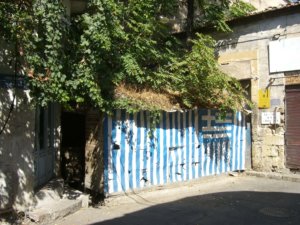
The EOKA campaign would be terminated in 1959, when the UK granted a very conditional independence to Cyprus, essentially putting the nominally independent republic under the triple suzerainty of Greece, Turkey, and the United Kingdom, with all of them given the rights to unilaterally intervene, to keep their armies on the island, and especially for the UK, to maintain absolute sovereignty of large areas surrounding their own military bases. This constitution, set in effect in 1960, would only last for three years before a new round of violence between the Greek and Turkish Cypriot paramilitaries was triggered by the Greek Cypriot leadership’s attempts to use independence as a stepping stone for union with Greece.
The result was the withdrawal of the Turkish Cypriots into militarised, densely populated, impoverished enclaves all over Cyprus, effectively rendering the bi-communal Republic of Cyprus a wealthy “second” Greek state. Total unification with Greece would be sought again in July 1974, when a Greek Cypriot coup d’etat, which had the backing of the Greek military junta, attempted to assassinate the Cypriot president and round up and execute any forces that were loyal to the Republic of Cyprus. The opportunity provided by the coup attempt was seized by the Turkish Republic, which conducted a military invasion under the pretence of restoring constitutional order.
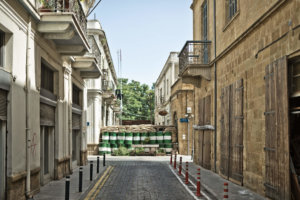
By August 1974, a division into a Greek Cypriot-controlled south (nominally still the Republic of Cyprus), and a Turkish Army-dominated north (nominally the Turkish Republic of Northern Cyprus) was solidified. A population exchange was swiftly agreed between the leadership of the two communities, and from 1974 to 2003, very few border areas in Cyprus could serve as points of meeting for the two communities, creating an entire generation which never met the Other outside of the descriptions found in militantly nationalist history textbooks.
In 2003, growing discontent within the Turkish Cypriot community forced the administration in the north to allow free movement of people, and the south had to follow, establishing a system of crossing points. Since then, only seven such crossing points exist across the internal border.
Militirisation as a cause of the crisis
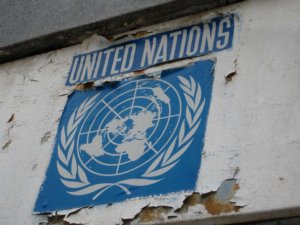
This is the short version of how we ended up with six permanent armies in Cyprus: the UK Armed Forces, a Greek regiment (ELDYK), the Turkish Army, the Greek Cypriot militia (National Guard), the Turkish Cypriot militia (TC Defence Force), and the United Nations multinational “peacekeeping” force which is stationed across the internal borders separating the two communities. In addition, many other (mostly NATO-aligned) armies are granted use rights and facilities for training, logistics support, or raiding purposes especially against Middle Eastern and North African targets.
Cyprus, too powerless to have its own imperialist ambitions, is the base of operations for imperialist interventions in Middle Eastern conflicts.
Cyprus, itself being financially, militarily and politically too powerless to have its own imperialist ambitions, is the base of operations for the imperialist interventions in this new round of Middle Eastern conflicts. The Conservative-Liberal DISY government maintains an equidistant policy aiming to please everyone, both NATO and Russia. Syria, the battleground of several contradictory interests of the imperialist powers, is the most recent country to be bombed by regiments hosted in the UK Sovereign Bases in Cyprus, while the Israeli Defence Forces are invited to hold joint training sessions in the southern mountainous areas of Cyprus since the terrain closely matches that of Lebanon.
Beyond the ineffective material support for the bombings abroad, which barely damage the Islamic State, “anti-terrorism” serves as the excuse for curtailing freedoms within Cyprus. Militarisation of the police force is under-way, and urban authorities are already engaging in “security-theatre practices.” It’s no surprise that military expenditure dwarves spending for social needs, even a decade into the most recent capitalist crisis.
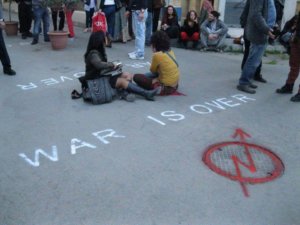
Military spending is causing and perpetuating this crisis. As social infrastructure is being slashed, spending on weapon systems is hardly being reduced. While pensions and wages have been cut, the arms industry continues to profit from new orders, as well as outstanding debts. Although Cyprus is considered to be the most recent casualty of the Eurozone crisis, it owes some of its debt troubles to a 50% increase in military spending over the past decade, the majority of which came after 2004, where one opportunity to reunify the island failed to gather support from Greek Cypriots in a referendum.
In the last two years, there have been efforts to “professionalise” the Greek Cypriot military in the south, by hiring some 3000 hundred “professional soldiers” (in addition to the already forcibly conscripted 18-year-olds), thus allocating budget that the austerity-implementing government claimed “simply didn’t exist” when hospitals, schools, and environmental protection agencies warned about severe material and personnel shortages. This shift of spending to defence and arms culminated in a devastating forest fire in 2016 which destroyed a huge chunk of forest, and took the life of two fire-fighters.
The fight against nationalism
Despite the nationalist frenzy, since 2003 when free movement between the two sides of the island was restored, several common initiatives were formed, aiming to counter the preachers of hate, demand the demilitarisation of the island and the recognition of the right to conscientious objection, and ultimately the reunification of the island in a federalist way which will allow societal struggles to move out of the shadow of the militaristic threat and take the main stage again.
There were parts of society which never stopped claiming a common space, and envisioning a common future. The Turkish Cypriot protests of 2011, the Occupy Buffer Zone in 2011-2012, and the many common actions on issues like antimilitarism, the annual Protest for a Demilitarised Nicosia, the Antimilitarist Peace Operation Concert, education such as the United Cyprus Teachers Platform, syndicalism, All-Cyprus Trade Unions Forum, and the various environmentalist struggles, all kept the bridges of reunification open.
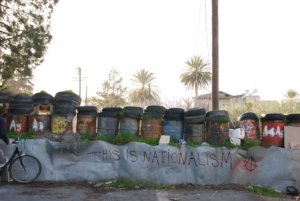
The disbandment of all armies will offer the framework we need to fight against the militirisation that dominates all aspects of life, like the patriarchy and sexism on which militarism relies upon.
Beyond the immediate material demilitarisation of the of the island, the disbandment of all armies will offer us the framework we need to fight against the other militirisations that dominate all aspects of life, like the patriarchy and sexism on which militarism relies upon for its reproduction. Even if at the same time the educational systems remain segregated, reunification will offer the opportunity to start a substantial dialogue —within the communities, as well as between them— with the aim of developing a system liberated from nationalism, racism, hatred, and the hegemonic discourse of the Church. The struggle for secularisation, not just of the educational system but of the state and society in general, will be carried out by all communities, and the secular character of the T/C community will greatly help the advocates of secularisation in the G/C community. The struggle against the appropriation of the Commons, land-grabbing, and environmental destruction will have a much wider scope.
Our actions to prevent environmental destruction in Mount Pentadaktylos/Beşparmak, in Androlykou/Gündoğdu, in Karpasia/Karpaz, and in Akamas will be united and will have the same goal: to combat the neoliberal and anti-environmental policies of the federal government and the business-owners who will operate under its protection. We hope to fight shoulder to shoulder with all residents of the island, regardless of their constituent-state of residence, and without giving any merit to their designations as “illegal immigrants,”“gypsies,” “Anatolian settlers,” or “bureaucratic remnants from Greece.”
It is obvious to us as Syspirosi Atakton that after the solution we will not live in a post-state context. We will continue to live under the control of a state that will be operating inside the capitalist system. That state will be called to react to certain geopolitical circumstances and it will use all the apparatuses in its disposal to enforce its power internally. We do know that we will have to fight against the policies of the federal state and the constituent states alike. We will do so. And we will do so together, not divided along nationalistic lines.
***
Featured image by Marco Fieber.
![Political Critique [DISCONTINUED]](http://politicalcritique.org/wp-content/uploads/2015/09/Political-Critique-LOGO.png)
![Political Critique [DISCONTINUED]](http://politicalcritique.org/wp-content/uploads/2015/09/Political-Critique-LOGO-2.png)
Cyprus suffered from a conspiracy instigated by the US and Britain to partition the country because it served their interest. As a result of their criminal plans, 200 000 Cypriots (because of their ethnicity) were expelled from their land and 40 000 NATO-Turkish occupational troops still remain in Cyprus. The once prosperous town of Varosha remains uninhabited.
When the NATO-Greek junta coup took place, the G/C resisted bravely and many gave their lives defending democracy.
Denktash explained that two Turkish Cypriots put the bomb in order to blame the Greek Cypriots, but this act was not committed by the Turkish Cypriot community. “It was an act of two hot-blooded young Turkish Cypriots,”
The retired Turkish Gen. Sabri Yirmibeşoğlu admitted that Turks burned mosques to increase animosity toward Greeks in Cyprus.
The British Major Martin Packard recalls being asked to take a visiting US politician, acting secretary of state George Ball, around the island. Arriving back in Nicosia, says Martin, “Ball patted me on the back, as though I were sadly deluded and he said: That was a fantastic show son, but you’ve got it all wrong, hasn’t anyone told you that our plan here is for partition?”
According to the BBC Radio 4 documentary programme “Document” transmitted on Monday 23 January 2006 evidence exists which shows that the UK was directly behind Turkish terrorism in Cyprus after it gained its independence in 1960 in order to bring about the partition of the island.
Both communities were victims of the extremists within their own communities as well as those of the other side. Many Greeks were forced to denounce their membership of AKEL and other organisation that were striving for peaceful relations between the two communities.
.
Both communities were victims of the extremists within their own communities as well as those of the other side. Many Greeks were forced to denounce their membership of AKEL and other organisation that were striving for peaceful relations between the two communities.
On 11 April 1965, Dervis Kavazoglou a Turkish Cypriot and Costas Mishaoulis a Greek Cypriot were murdered together in their car by T/C members of the terrorist organization (TMT). Below are extracts from some of the speeches of the late Kavazoglou:
“They have managed to drive the young people of Cyprus, Greeks and Turks on the mountains to fight and kill
each other. Only yesterday they were working together in the workshops, offices, and in the mines, they were ploughing the same earth to provide bread for their families”. They have created the myth and the lie that
is impossible for the two communities to co-exist in peace. They drove 20 000 Turks out of their homes and put them in places which are not different from concentration camps. Thus establishing the base for a future partition” “a handful of fascists by using guns and fascists methods snatched the leadership of the Turkish community. They are the ones that cause the suffering of the Turkish Cypriots”.